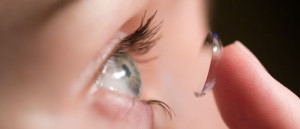The Beginner’s Guide to Contacts
- Dec 22, 2014
- Beauty
Are you tired of wearing your spectacles and want to switch over to contact lenses, but are still a little skeptical? Relax! Today, there is a wide variety of contact lenses available in the market, each created to suit every distinct requirement of yours. They are safe, easy-to-use and pocket-friendly. In order to help all first-time users of contact lenses to get started, we have compiled a step-by-step beginner’s guide to contacts. Read on!
Types of Contact Lenses
Soft Contact Lenses
Soft contact lenses, also called Hydrophilic or Hydrogel lenses, are made of soft, flexible plastics that allow oxygen to pass through to the cornea. Soft contact lenses are easy to adjust to and very comfortable especially for new users.
Rigid Gas Permeable (RGP) Contact Lenses
Rigid gas permeable contact lenses (RGPs) are durable and resistant to deposit build-up, and generally give a clear and crisp vision. They tend to be less expensive they last longer than soft contact lenses. They are easy to handle and less likely to tear. However, they are not as comfortable initially and may take a few weeks to get used to. It is generally a good idea to start off with soft lenses and move on to RGPs as you get used to the concept.
Extended Wear Contact Lenses
Extended wear contact lenses are designed for overnight or continuous wear ranging from one to six nights or up to 30 days. Extended wear contact lenses are usually soft contact lenses. There are also a very few rigid gas permeable lenses that are designed and approved for overnight wear as they are not as flexible and may cause discomfort in sleep. Duration of continuous wear of lenses depends on the lens type and your eye care professional’s evaluation of your tolerance for overnight wear. It’s important for your eyes to have a certain amount of breathing time, free from lenses, for at least one night before the next cycle begins.
Disposable Contact Lenses
Most of the soft contact lens wearers are prescribed with a frequent replacement schedule, after the expiration of which the contacts must be discarded. “Disposable,” as defined by the FDA, means used once and thrown. With a daily wear disposable schedule, a brand new pair of lenses is used each day and thrown at the end of it.
Some soft contact lenses are referred to as “disposable” by contact lens sellers, but actually, they are for planned replacement. For example, for 7 days to 30 days, and then thrown away. Care has to be taken that when you remove your lenses, make sure to clean and disinfect them properly before reinserting.
How to put on Contact Lenses
For new users, wearing and removal of contact lenses can be quite a challenge. But by following a few simple steps, this process can become child’s play within a week of practice.
- Wash your hands properly with soap in order to disinfect your hands before handling lenses.
- Remove the lens from the lens case and place it on the index finger. Keep the lens away from your nails as they may get injured.
- Ensure that the concave side of the lens is facing upwards while the convex side is resting on your finger tip.
- With the middle and index finger of your other hand, to pull the skin of your lower and upper lid away from your eyes. This creates ample space to insert the lens comfortably.
- Now place the lens gently over the eyeball, without blinking.
- Once inserted, close your eyes for a few seconds to remove any air bubbles.
- Repeat for the other eye.
- To remove lenses, wash your hands thoroughly again. Pull the skin away from your eyes as before. Displace the lens from over your eyeball to a corner of the eye. Now gently squeeze and pull the lens out.
How to Care for Your Lenses
- It is highly imperative to clean and disinfect your contact lenses before and after each use.
- Contact lens cases should be cleaned daily and it is recommended that you replace your case every three months.
- Contact lens solution should never be reused as it may contain latent bacteria.
- Water or other homemade cleaning solutions should never be used as they can cause serious eye infections and also damage the lenses.
- Eye drops, even non-prescription ones, can interact with all types of contact lenses. Only the prescribed brand of solution should be used. You could also check with your optometrist before changing brands.
Top 5 contact lenses brands
- SofMed by Cooper Vision
- Acuvue by Johnson & Johnson
- Air Optix by Alcon
- Proclear by Cooper Vision
- Soflens by Bausch + Lomb
Some risks of using contact lenses
- Frequent eye infections
- Severe allergies
- Dry eye (Due to sleeping with or overshooting prescribed duration of lens)
- A work environment that is very dusty or dirty
- Inability to handle and care for the lenses properly
- Pink eye (conjunctivitis)
- Corneal abrasions
However, let not the risks bog you down. With proper care and handling of your lenses, all of the problems mentioned above can easily be avoided. So visit a doctor today, and find out which type of lenses best suits you. Remember, 20% of the American population uses contacts every single day without any hassles. So go ahead, reveal those dazzling eyes you’ve been hiding behind your glasses for all this time!


Leave a Reply